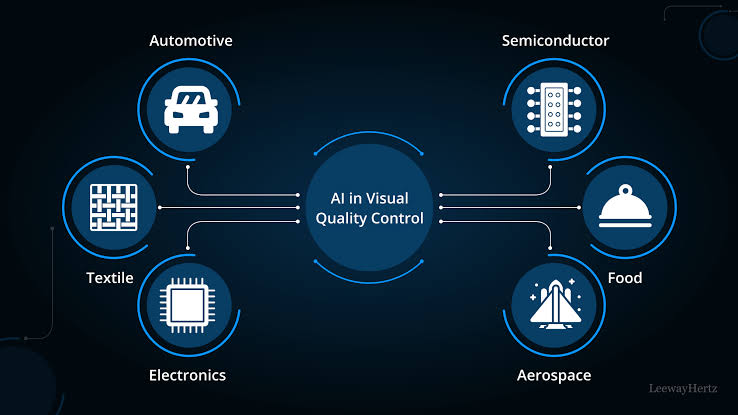Explore how AI-driven quality control is transforming manufacturing by enhancing accuracy, efficiency, and consistency. Learn about the role of machine learning, computer vision, and data analytics in detecting defects, optimizing production, and ensuring high standards of product quality.
In today’s manufacturing landscape maintaining high standards of quality is essential for success. Traditional quality control methods often rely on manual inspections. They are labor-intensive processes. However, artificial intelligence (AI) has revolutionized this field. It provides innovative solutions that enhance precision efficiency and consistency. AI-driven quality control systems are transforming production by automating processes. They offer real-time insights. This ultimately ensures excellence in manufacturing.
Understanding AI-Driven Quality Control
AI-driven quality control integrates artificial intelligence technologies into quality assurance processes of manufacturing. These systems use machine learning algorithms computer vision and data analytics to detect defects, ensure compliance with specifications and optimize production workflows. By automating quality control AI systems reduce human error. They improve overall product quality
The Role of Machine Learning in Quality Control
Machine learning, a subset of AI plays crucial role in modern quality control systems. Machine learning algorithms analyze historical production data to identify patterns and anomalies. These algorithms are trained on past defect data and successful quality practices. They detect issues in real-time. As system processes more data, it refines its accuracy and predictive capabilities. This allows for proactive quality management
Machine learning offers adaptability. It can evolve with new data. Unlike traditional systems that rely on static rules machine learning algorithms continuously learn and improve. This makes them capable of detecting emerging defects or changes in production quality
Computer Vision for Defect Detection
Computer vision technology uses cameras and image processing algorithms to inspect products during manufacturing. High-resolution cameras capture images. These images are analyzed by computer vision algorithms to identify defects deviations from specifications, or inconsistencies. Computer vision systems detect wide range of issues. These issues can range from surface imperfections like scratches to structural anomalies. Automating inspection process with computer vision reduces need for manual checks. It also speeds up defect detection. This ensures higher rate of accurate quality assessments. Consequently this leads to fewer defective products reaching consumers and more efficient quality control process.
Data Analytics for Continuous Improvement
Data analytics is integral to AI-driven quality control. It provides valuable insights into production processes and product quality by analyzing data from various sources including sensors, inspections production metrics. This analysis helps identify trends, patterns that may indicate underlying issues.
For instance data analytics can reveal relationships between machine settings and defect rates. It helps manufacturers address root causes of quality problems. Predictive analytics forecast potential issues before they arise, enabling preventive measures and reducing risk of costly recalls or rework. This proactive approach enhances overall product quality and operational efficiency
Benefits of AI-Driven Quality Control
AI-driven quality control offers several advantages for manufacturers
- Enhanced Accuracy: AI systems can analyze data with high precision. This reduces human error and improves defect detection accuracy
- Increased Efficiency: Automating quality control processes speeds up inspections. It reduces time needed for quality checks resulting in faster production cycles
- Real-Time Monitoring: AI systems provide real-time insights into production quality. This allows for immediate corrective actions and minimizes defect impact
- Cost Savings: By reducing manual inspections and number of defective products, AI-driven systems can lead to significant cost savings
- Continuous Improvement: Machine learning and data analytics enable ongoing improvements in production processes and product quality driving long-term benefits
Challenges and Considerations
Despite its advantages AI-driven quality control presents challenges
- Data Quality: Effectiveness of AI systems depends on quality of data used for training and analysis. Inaccurate or incomplete data can affect algorithm performance
- Integration: Implementing AI-driven quality control involves integrating new technologies with existing production systems. This may require initial investment and workflow adjustments
- Maintenance: AI systems need regular updates and maintenance to remain effective. This includes monitoring performance and retraining algorithms as necessary
- Security: Ensuring data security and protecting AI systems from cyber threats is crucial. Robust security measures must be in place to safeguard sensitive information
Future Directions in AI-Driven Quality Control
The future of AI-driven quality control is promising with ongoing technological advancements. Emerging trends include use of advanced sensors and more sophisticated machine learning algorithms. Also increased integration with other Industry 4.0 technologies is notable. These developments will further enhance AI-driven quality control systems. They foster innovation and maintain high standards in production.
In summary, AI-driven quality control reshapes manufacturing industry by offering improved accuracy and efficiency. It also promotes continuous improvement. By leveraging machine learning computer vision and data analytics, manufacturers can achieve high-quality standards. They also can optimize production processes. While challenges exist benefits of AI-driven quality control make it valuable investment for ensuring excellence in production
